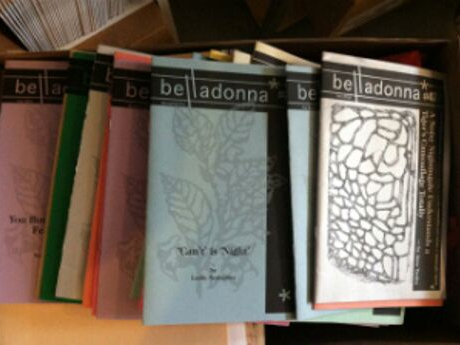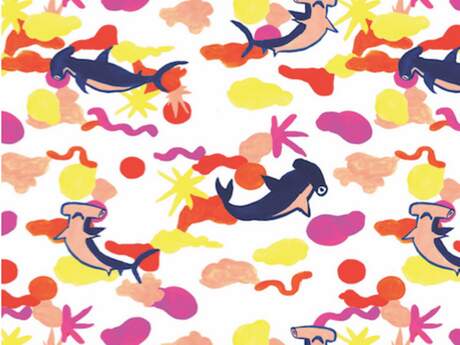Q & A: Chapbook Publishers
Krystal Languell on Belladonna*

Krystal Languell was born in South Bend, Indiana. Two chapbooks and a full-length collection of poetry are forthcoming: LAST SONG (dancing girl press, 2014), BE A DEAD GIRL (Argos Books, 2014) and GRAY MARKET (Coconut, 2015). FASHION BLAST QUARTER was published as a poetry pamphlet by Flying Object in 2014. A core member of the Belladonna* Collaborative, she also edits the journal Bone Bouquet. She was a recipient of The Poetry Project's Emerge Surface Be Fellowship, during which she worked with Anselm Berrigan.
* * *
What is your own personal history with chapbooks? How did they first catch your interest?
As a graduate student at NMSU and an intern at Noemi Press in 2009, I first learned about chapbooks through Noemi's publishing catalogue. On the floor of the Puerto del Sol office I stapled Sarah Veglahn's Closed Histories and Rebecca Bednarz's Camera Obscura. I discovered Belladonna* when Carmen Giménez Smith (publisher of Noemi and my MFA thesis advisor) assigned Lila Zemborain's full-length book Mauve Sea-Orchids, and Belladonna* sent me some chaplets as a bonus. Also around this time I found out (through 2009's AWP?) about Ugly Duckling Presse, and got Dodie Bellamy's Barf Manifesto.
Listing each of these books/lets gives me a greater sense of my education and also the inevitability of my route to NYC in retrospect. But each of these chapbooks was easy to hold, easy to read lying on my back in 100 degree weather, when it is too much to ask to hold up anything bound with glue, and seemed more accessible as a publishing goal for my own poetry, too. What happened next for me was that a new chapbook press accepted a manuscript I submitted, and then the press folded. This was in 2009 too, and only now, in 2014, do I have my first chapbook coming out! (A full-length was published in 2011.) It's been a long journey, me and chapbooks.
What made you first decide to start publishing chapbooks?
When I became part of Belladonna* in 2010, the chaplet series had been on pause for a year or two. I had a lot of energy for it to start back up—number 125 AKA Elders #8 (Did you know the Elders Series is numbered both 1-8 as books and 118-125 as chaplets? Belladonna* trivia!) had been the last issued; to me it seemed that anything that had lasted so long, for 125 publications, should continue as long as possible. We picked it up in 2011, starting at that year's AWP with a prose event involving Vanessa Place, Eileen Myles, and Bhanu Kapil (#126-128), continuing in February with Body of Words (#129), a multi-author chapbook and event combining dance and poetry, and in April of that year Flux Poetics: writing from cultural duality with Carmen Giménez Smith, Tsering Wangmo Dhompa, and Cecilia Vicuña (#130-132). Since then, we've published 12-18 chaplets each year, most recently #161 for AWP 2014: Against the Private Zoo, with contributions from eight writers.
Could you talk a little bit about your own process of making and publishing chapbooks?
Our process is a torrent of emails.
The Belladonna* chaplet series is deliberately lo-fi; we print at a copy shop (shoutout to Wholesale Copies on 28th St, generous and patient) and our covers are of a uniform design—the image is a belladonna flower found in HR Hegnauer's yard. The books are 8.5x11 folded over, stapled, like a zine. This method of production mirrors the idea of ephemerality, which we are interested in as documentarians. Bill Mazza is our designer, and once a year or so I design one myself.
We print 126 copies of each chaplet, 26 of which are signed by the author and numbered (these are collected by university libraries including Brown, NYU-Fales, University of Buffalo, University of AZ Poetry Center, etc), 5 or 10 of which are given to the author, and the remaining 90 or so are available for sale in person at the event or on our website.
What is unique about the chapbook form, or why chapbooks and not book-books?
Belladonna* does both chap- and book-books. Certainly the chapbooks are less expensive to create, though we are also very committed to our full-length books. I think this ties back to the ephemerality and immediacy Rachel addresses in her January 2003 text.
The series creates a historical record of NYC poetry and politics; it's a record of the event, which happens in a time and a place, but it's also a record of/for/about the person who is reading and performing at that event, their work at that moment, which for our readers often goes on to be part of a full-length collection. (This has been true of R. Erica Doyle's proxy, Eleni Sikelianos' The Book of Jon, Rachel Zolf's Human Resources and more.)
Do you have recent favorite chapbooks from another press?
Dancing Girl Press, run by Kristy Bowen in Chicago, is one of the longest-running feminist chapbook series I know about, and it's a one-woman operation. Kristy was part of my inspiration to start my poetry journal Bone Bouquet and I tell you I did not make it very long before I realized publishing as a one-woman operation is too hard for me, and I recruited additional editors. Hats off to Kristy Bowen. Others I recommend include: Birds of Lace run by Gina Abelkop, Little Red Leaves run by Dawn Pendergast, and (though I haven't read their books yet) Antena by Jen Hofer looks like a really important and energizing project too.

